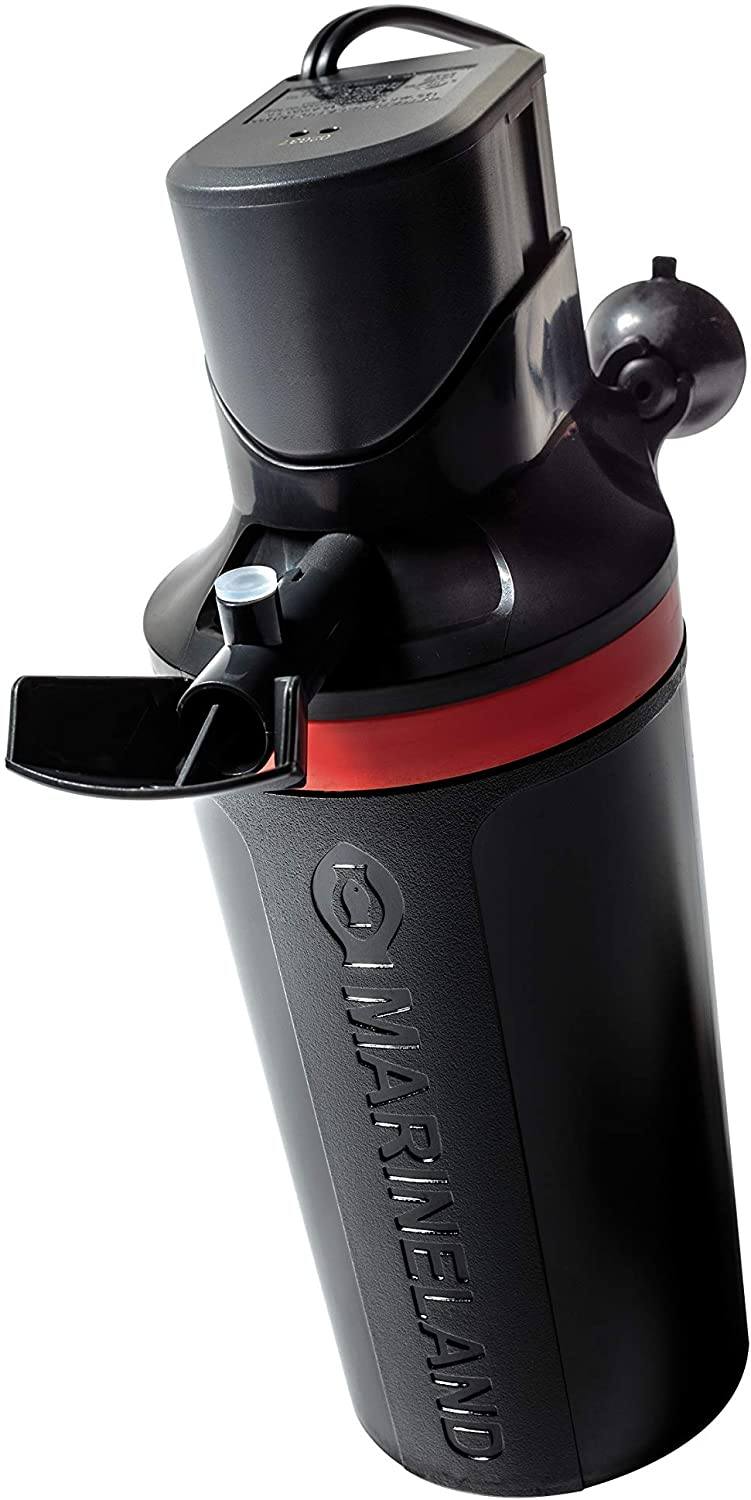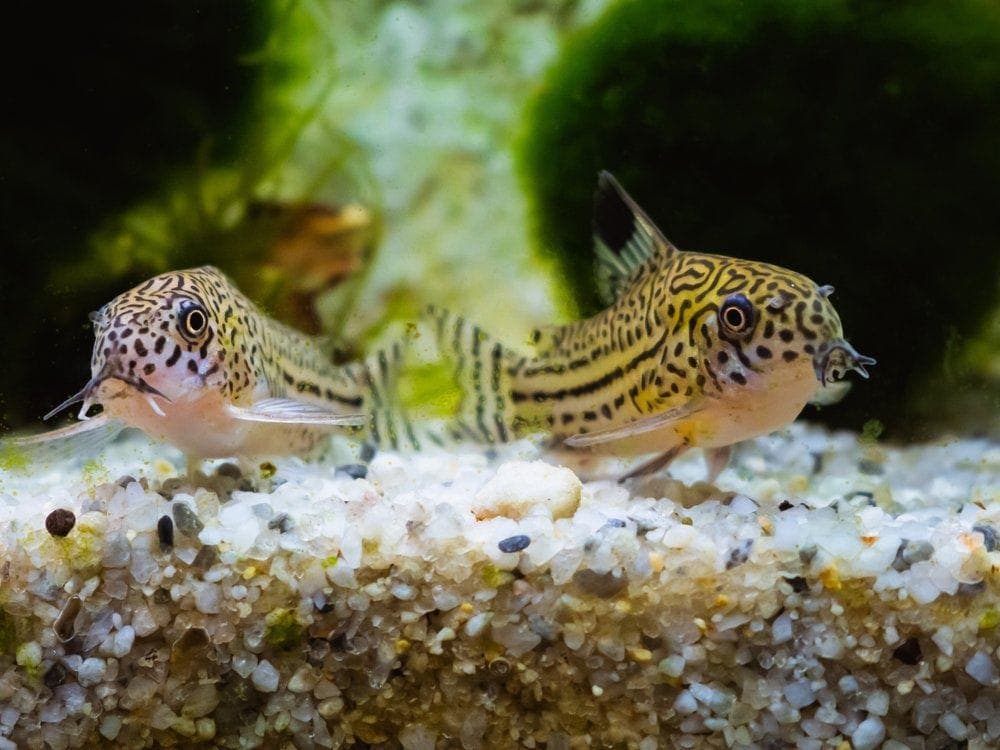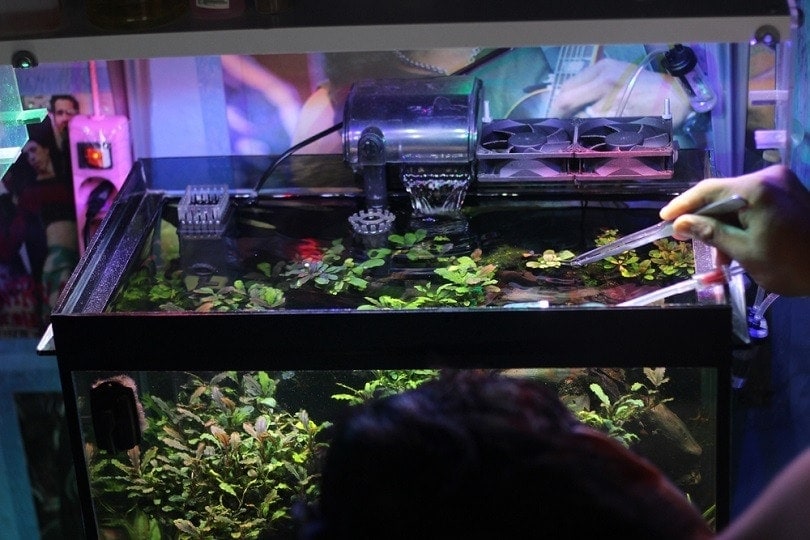Celestial Pearl Danio: Care Guide, Types, Lifespan & Pictures

Updated on
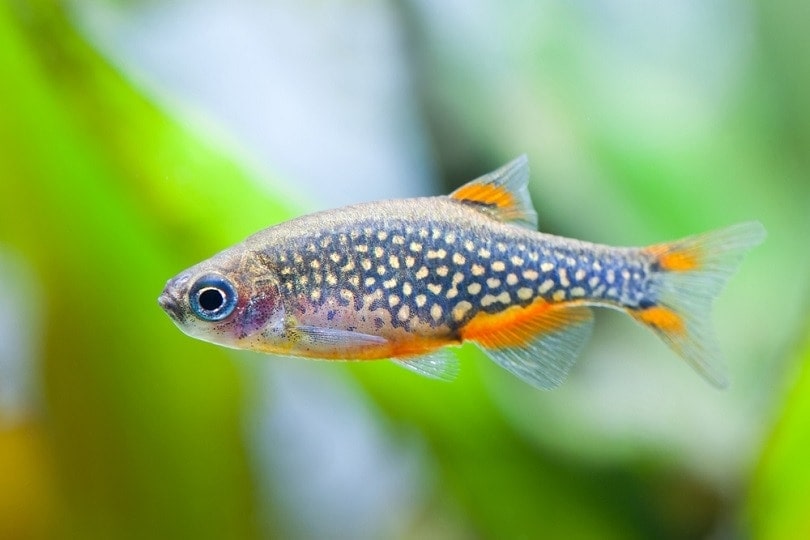
The celestial pearl danio (Danio margaritatus) is a small freshwater fish found in ponds that are rich in vegetation in their native country of SouthEast Asia. These small fish are attractive with their pearl white spots on their body and red colors that are present on their fins. Celestial pearl danios are relatively new to the aquarium industry and were only discovered this past decade. They do well in tropical freshwater tanks that host an abundance of vegetation to mimic their natural habitat.
This guide will provide you with everything you need to know on how to properly care for your celestial pearl danio.
Quick Facts about Celestial Pearl Danios
| Species Name: | Danio margaritatus |
| Family: | Cyprinidae |
| Care Level: | Moderate |
| Temperature: | 22°C to 26°C |
| Temperament: | Peaceful & timid |
| Color Form: | Red coloration on the fins, white spots in the body |
| Lifespan: | 2–5 years |
| Size: | 1 inch |
| Diet: | Omnivores |
| Minimum Tank Size: | 20 gallons per 10 fish |
| Tank Set-Up: | Freshwater, heavily planted |
| Compatibility: | Communities |
Celestial Pearl Overview
Celestial pearl danios were discovered recently in early 2006. They became increasingly popular after the discovery due to their colorful bodies and peaceful nature. They quickly stole the hearts of community fish aquarists who fell in love with both their colors and personality. They are a member of the cyprinid family and are commonly called galaxy rasboras. These fish add an appealing pop of color within the aquarium and stand out amongst green vegetation.
When they are kept in appropriate conditions, they can live up to 5 years. Although if they are kept in average or poor conditions you can expect them to live between 2 to 3 years.
Celestial pearl danios may be small, but they form large groups and require a large, planted tank set up. They have a shy and peaceful nature that makes them appropriate for community tanks. They are tropical fish but do not do well in tanks with temperatures that exceed 26°C. They should be kept in tanks with small fish that will not prey on them. They are easily stressed and are prone to hiding when they feel unsafe. Keeping celestial pearl danios in large groups in an appropriate tank set up is great for novice aquariums. They are perfect for nano tanks and look attractive in a planted tank on a desk. They are also great for children who will be interested to watch these colorful fish swimming within the tank.
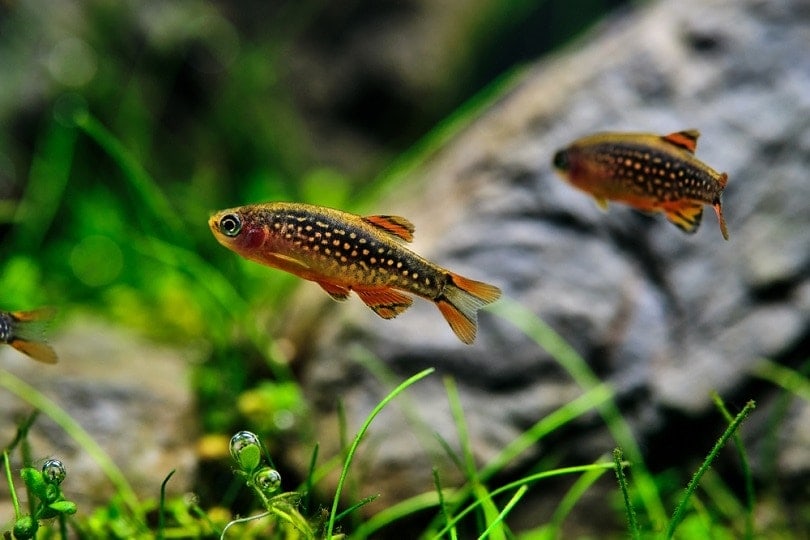
How Much Do Celestial Pearls Cost?
Due to their small and sensitive nature, celestial pearl danios are cheap both online and from pet stores. These fish are usually $1 which makes them able to be purchased in large groups. It is best to purchase more than 10 celestial pearls so they can form a shoal. The price range depends on the health, size, and quality of the fish. If you decide to purchase a shoal of celestial pearl danios online from a reputable breeder will cost more due to the shipping costs. Transportation should be within 24 hours because they do not do well with transportation where the temperature will fluctuate.
Typical Behavior & Temperament
Celestial pearl danios are shy fish with a peaceful temperament. They display shoaling behavior and can become very timid when disturbed by larger fish or fish that are aggressive by nature. They are prone to hiding within aquarium decorations or behind plants. They are less timid when kept in a heavily planted tank with no sparsity between the plants and decorations. Logs such as driftwood work well in the middle of the tank to be used as an extra piece of shelter for them. They are easily stressed when kept in bowls or biosphere and the curved sides will distort their vision. Tanks should be rectangular and shallow to keep them happy.
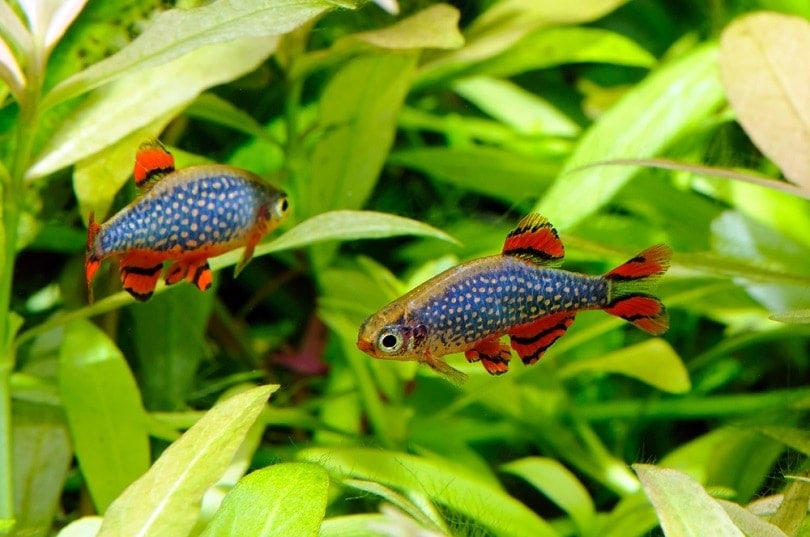
Appearance & Varieties
The contrast between a tank’s backdrop and their vivid colors enhances their appearance which consists of a blue, semi-transparent body with bright red fins. They are then decorated with pearl white dots. Their color depends on diet, the amount of stress they experience as well as their gender. Celestial pearl danios will show their color’s true potential when they are kept in an appropriate environment with a diet high in meat-based protein.
When they are stressed, their color will begin to dull, and their fins can turn dark orange. All their fins consist of a pair of distinctive black lines. These fish have sexual dimorphism, and their color can vary with the two different genders. This makes it easier to determine the gender of your celestial pearl danio. The males are typically thin and display more vivid colors starting with the tail. The females are duller and have a rounded belly.
When the males are courting, they will develop a ruby red coloration on their stomachs. This makes aquarists seek the males out more. It is important to remember to keep a good ratio of males and females within the tank to ensure the females are not being harassed by a large group of males to mate.
Males will also fight each other for a mate which can be avoided by keeping an appropriate number of males. More females in a shoal are recommended than males. Due to these fish being a newly discovered species, conservation is being discussed to where they fit into the Cyprinidae genus. They share their general shape with other members of the cyprinid family and share the same spotted pattern as other types of danios, for example the dwarf danio fishes. These fish easily take the role of the most attractive fish in the tank.
How to Take Care of Celestial Pearl Danios
Habitat, Tank Conditions & Setup
Tank/aquarium size: Celestial pearl danios need to be in a tank that is no smaller than 15 gallons. They require a group of 10 to properly group to mirror their natural shoaling behavior. Although they are small, a group of 10 should be in a tank of at least 20 gallons at minimum. If you plan to add in more of them, you should aim to keep a tank of 40 gallons for 20 danios. To replicate their natural environment, you should add their natural substrate and plants into an appropriately sized tank. All their essential items should be able to fit into the tank with enough swim space leftover.
Water temperature & pH: The ideal temperature for these fish is 22°C to 26°C. They are tropical fish and require a heater. The temperature should be preset and not fluctuate. The temperature should not exceed 28°C or they seem to become lethargic. The water should be acidic with a pH between 6.5 to 7.5. The water hardness should be soft to medium.
Substrate: A dark substrate that is rich in nutrients for live aquarium plants is recommended. The substrate should be at least 2 inches to provide the roots of the plants with enough room to appropriately root. A thick level of granular gravel works well too.
Plants: Celestial pearl danios require a heavily planted tank to remain happy and healthy. Plants that grow both small and bushy are best for these fish. You want to avoid floating plants like duckweed as it blocks out light for the fore-growing plants.
Lighting: These fish do not do well in brightly lit tanks and need soft to moderate lighting. This can be achieved from both artificial and natural light. It should be bright enough to meet the light requirements for the plants within the tanks.
Filtration: They originate from slow to still moving water and this should be replicated in the tank conditions. They do best with a filter that does not produce a strong current but filters five times the water volume in a minute. They need clean and filtered water to thrive.
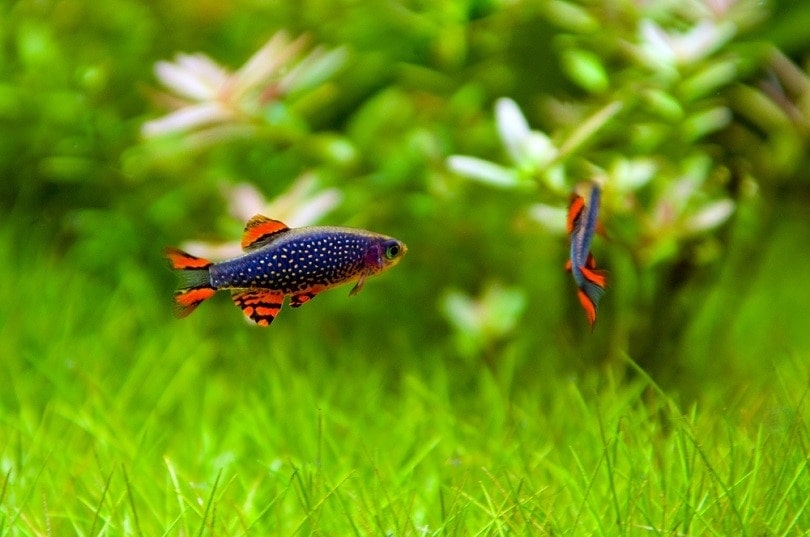
Are Pearl Danios Good Tank Mates?
They may be shy fish, but they do appreciate other peaceful and compatible tank mates. Celestial pearl danios do well in small peaceful communities. Fish that are small and ignore other fish in the tank can be housed with these fish. The tankmates should be small enough to not eat or attempt to swallow the small pearl danios. You should aim to keep other types of schooling fish that swim at different levels. Other tankmates should be able to complement these fish both by their coloration and temperament.
There are exceptionally few large or medium-sized fish that get along with pearl danios due to the size difference. It is important to ensure the tank mates are suited to the similar conditions you will be keeping your pearl danio in. Avoid aggressive fish like Oscars and cichlids who will prey on these small and vulnerable fish. Keep fish that occur in a similar habitat to pearl danios and will not interfere with their shoaling behaviors. Avoid overcrowding the tank, this will only lead to stress amongst the inhabitants.
- Guppies
- Killifish
- Tetras
- Corydoras
- Rasboras
- Zebra danios
- Acaras
- Goldfish
- Shrimp
- Oscars
- Cichlids
- Blood-parrots
- Jack Dempsey’s
What to Feed Your Celestial Pearl Danio
These fish naturally eat many algae and small organisms in the wild. This should be mirrored in their captive diet to achieve their best growth and coloration. Pearl danios also consume plants and zooplankton. They display such a varied diet because of their opportunistic consumption behaviors. They are omnivores by nature and require equal amounts of vegetative and meat-based foods in their captive diet. They should be fed quality sinking granules, pellets, and flakes that are specifically made for small tropical shoaling fish.
Supplementation is required within their diet in the form of algae in its pure or pellet form. They should have grazing access to the live aquarium plants and be fed bloodworms, tubifex, and other smaller worms as a weekly snack for extra protein. You can also grow your live foods, so they have constant access to protein-rich foods. Starting a mosquito or white worm hatchery is a good option. Enriching the pearl danios diet is a quick way to increase their overall health and immunity. If they are eating the right foods, your pearl danio will remain vibrant and active.
Keeping Your Pearl Danio Healthy
If you want your pearl danio to live for their maximum lifespan, you should meet all their care requirements. Minimize the amount of waste in the tank by placing a quality filter in the tank. Keep the flow on the lowest point of use plants to manually slow down the current by blocking it. Keep their diet varied and rotate the supplements throughout the week to make sure your pearl danio is getting all their necessary vitamins and minerals.
Do not overfeed or underfeed them as this will place stress on their body and affect development and growth. Keep them in a large group and do not sparsely decorate the tank. A healthy pearl danio will have a proportionate body with vivid colors. Do regular water renewals to minimize the amount of ammonia, nitrites, and nitrates within the tank. Do regular gravel vacuums to remove accumulated debris and waste. Do not overstock your pearl danios tank. If you plan to keep other fish with them, 40 gallons wide is recommended for a group of 10 pearl danios with other small fish.
Breeding
Breeding pearl danios is an easy task. Be on the lookout for females that are more darkly colored with a rounded abdomen. This is an indication that she is ready for spawning. The males should develop a brighter color and fight amongst each other for females. Courting behavior will be high amongst the shoal. Live foods are ideal to encourage breeding behavior amongst pearl danios. They are egg layers, and the females will deposit eggs throughout the tank. The females will not lay their eggs in a tank with a strong current. This is because the stress to swim unnaturally will be high amongst your pearl danios.
Once the eggs are fertilized, you should remove them immediately as the males will seek out the eggs to eat. This can be done inside of a breeding tank with similar environments as the main tank. The breeding tank should be planted and have a still to slow water movement. To stimulate breeding, feed them live foods a week before you plan to breed them. Once the eggs hatch, the fry will rapidly grow and develop with a good diet and environment. Brine shrimp and small fry pellets will suffice for the fry.
Are Celestial Pearl Danios Suitable For Your Aquarium?
If you are looking for a small and hardy shoaling fish for your freshwater tropical aquarium, the celestial pearl danio may be suitable for your aquarium. These fish add a bright and cheerful color to your tank and work well in peaceful communities. If you keep a heavily planted aquarium with compatible tankmates, pearl danios may complement your tank and other inhabitants well. A strong current is to be avoided and you should only place pearl danios in calm water movements. It is best to have basic knowledge of small tropical fish care before you attempt to care for a group of celestial pearl danios.
Due to their small stature, they can be more complicated to care for than other shoaling fish. Overall, they make great additions to an appropriate set-up and stocked tank. We hope this guide has informed you of the proper care requirements for the beautiful celestial pearl danio.
Featured Image Credit: Besjunior, Shutterstock




